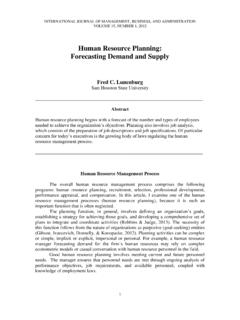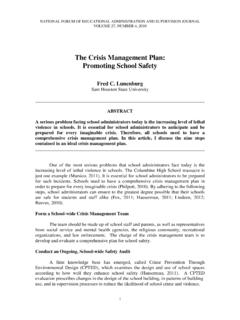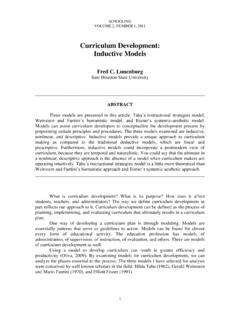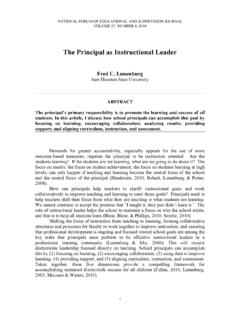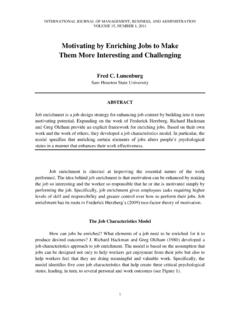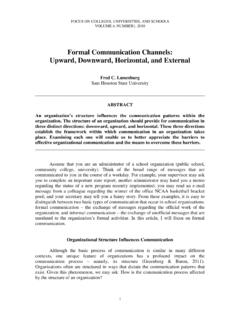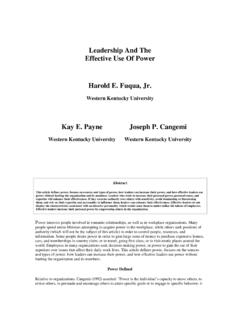Transcription of The Comer School Development Program: Improving …
1 NATIONAL FORUM OF MULTICULTURAL ISSUES JOURNAL VOLUME 8, NUMBER 1, 2011 1 The Comer School Development Program: Improving education for Low-Income Students Fred C. Lunenburg Sam Houston State University _____ ABSTRACT The Comer School Development Program (SDP), also known as the Comer Process or Comer Model, was developed to improve the educational experience of poor ethnic minority youth. The nine component process model includes three mechanisms ( School Planning and Management Team, Student and Staff Support Team, and Parent/Family Team); three operations (Comprehensive School Plan, Staff Development Plan, and monitoring and assessment), and three guiding principles (collaboration, consensus decision making, and no-fault problem solving).
2 Initially developed by James Comer and the Child Study Center at Yale University in 1968, the program is now being implemented in 1150 schools, 35 School districts, and 25 states. Studies of selected SDP schools show significant student gains in achievement, attendance, behavior, and overall adjustment in SDP schools. _____ The School Development Program (SDP), also known as the Comer Process or the Comer Model, is intended to improve the educational experience of poor minority youth. Improvement is attained by building supportive bonds among children, parents, and School staff to promote a positive School culture.
3 Since 1968 when the model was created by child psychiatrist Dr. James Comer and his colleagues at the Yale University Child Study Center, it has been utilized in more than 1150 schools nationwide. While the SDP helps bring change to one School at a time, it has been used as a framework for system-wide reform. James Comer and the Yale University Child Study Center staff developed a SDP theory of change. They hypothesize that the introduction of the SDP model directly influences the proximal outcomes of School organization and management; influences School culture both directly and through its effect on organization and management; and affects classroom practices both directly and through its effects on organization and School culture.
4 Classroom factors, in turn, affect the distal outcome of student achievement both directly and through their influence on other distal outcomes like student attitude and behavior. NATIONAL FORUM OF MULTICULTURAL ISSUES JOURNAL 2_____ In short, in the Yale University Child Study Center theory, implementation of the School Development Program transforms the School into a learning environment that: builds positive interpersonal relationships; promotes teacher efficacy; fosters positive student attitudes; increases students pro-social behaviors; and improves student academic achievement.
5 While the arrows in the figure show principal direction of influence, in reality the relationships are reciprocal and feedback loops exist between virtually every pair of points in the model. The SDP theory of change is shown in Figure 1 (Yale University Child Study Center, 2011). Rationale Underlying the Program All the recent neuroscience research indicates that nature versus nurture is not an either or thing (Tyson, 2012). Development and learning are inextricably linked. To help children, schools need to address both learning and Development (Bulach, Lunenburg, & Potter, 2008).
6 The School Development Program takes a uniquely supportive view of education with a focus on developing the whole child (Joyner, Comer , & Ben-Avie, 2004a). Unlike models with a formulaic approach to curriculum or School Climate & Culture Factors External Factors School Org. Factors SDP MODEL Student Academic Achievement Factors Classroom Factors Student Behavior Student Attitudes Indirect Effect Direct Effect Figure 1. The Yale School Development Program Theory of Change Figure 1. The Yale School Development Program Theory of Change. FRED C. LUNENBURG _____3 teaching methods, this holistic strategy links children s academic growth with their emotional wellness and social and moral Development in a collaborative School culture congenial to learning.
7 The program is derived from the idea that when students feel supported and nurtured in School , their outlook, life skills, and academic performance will improve (Lunenburg & Ornstein, 2012). Comer (2010) believes that for various reasons, many inner city children enter School underdeveloped, lacking the personal, social, and moral traits necessary for academic success. Consequently, students who have not had adequate support for their Development may come to School lagging behind their classmates who may have had an optimal preschool developmental experience. This may have a negative effect on students learning skills.
8 Comer also believes that many teachers lack adequate knowledge of child Development or an understanding of their students home lives and culture, leaving them unprepared to deal appropriately with these children and their families to effectively foster their learning (Maholmes, Haynes, Bility, Emmons, & Comer , 1995). History of the Program The program began in two poor, predominantly African American elementary schools in New Haven, Connecticut, with low standardized test scores and high teacher and student absenteeism. Comer and his colleagues developed an organizational and management system based on child Development issues that would encourage teachers, administrators, and parents to collaborate to address children s needs ( Comer , 1992, 1993; Comer & Haynes, 1991; Comer , Haynes, Joyner, & Ben-Avie, 1996).
9 The program was field-tested from 1978 to 1987 in additional schools in New Haven and in three other School districts: Prince George s County, Maryland, Benton Harbor, Michigan, and Norfolk, Virginia. Beginning in 1988, the dissemination phase emphasized partnerships between teacher-training institutions and local School districts in New Orleans, Cleveland, and San Francisco, as well as the establishment of Regional Professional Development Centers. In 1990 the Rockefeller Foundation granted a five-year, $15 million grant to aid national replication (Payne, 1991). Originally, any interested School could implement the model with technical assistance.
10 In 1996, in response to research evidence, schools could not implement the full model without School district office support and the involvement of several schools in the same district ( Comer , et al., 1996). The replication model includes the following phases: (a) pre-orientation phase: School personnel become acquainted with the model and decide if it will be implemented and who will be the major participants; (b) orientation phase: Initial training of School personnel and parents and the establishment of a governing board; (c) transition phase: Goals and objectives are established by the governance board with input from all participants.
